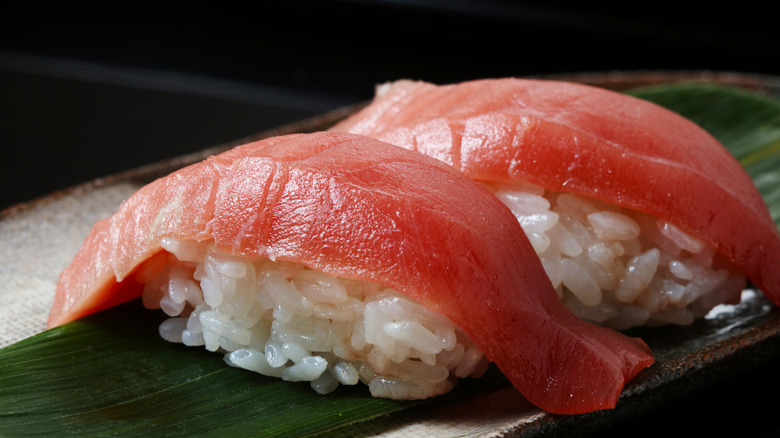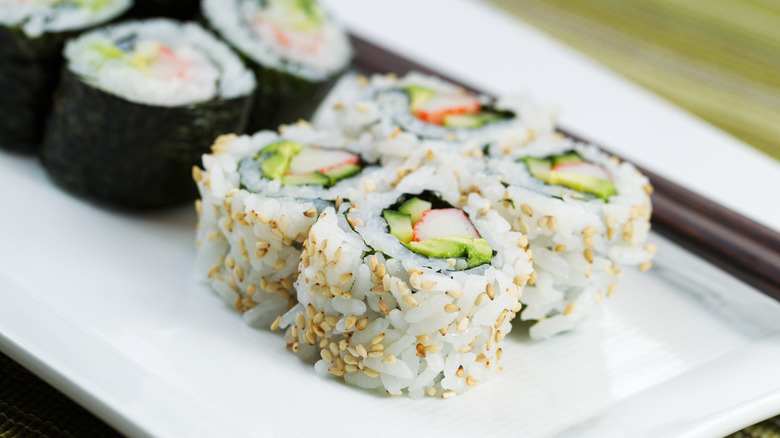The Price Of One Type Of Tuna Has Risen By 10,000% Over 2 Decades
The king of sushi fish, the absolute cream of the aquatic crop, is bluefin tuna. Selling for exorbitant prices in Tokyo's legendary Tsukiji fish market, bluefin is prized for its rich, smooth taste, and though other species are often substituted for cost reasons, bluefin is still the most sought-after variety. Above all else, toro — "fatty tuna," from the belly of the fish — is the type for which aficionados go absolutely nuts.
Though it's not beloved by all (some people just can't get their heads around the idea of raw fish), sushi is now a widespread cuisine present in virtually every major and even small American city; it's as integral to the fabric of American culinary life as Italian or Chinese food. But it wasn't always this way. Until the 1960s, sushi didn't really exist in America at all, and it took a couple of decades after that for it to become a significant culinary presence. What's wild, though, the notion of bluefin as the prize of the sushi world didn't come from Japan, it came from America — and its rise reshaped an entire economic ecosystem.
No one in either America or Japan wanted bluefin until the late 20th century
Prior to the 1970s, bluefin was all but valueless. According to The Atlantic, it was typically only good for sale as cat food. To make matters worse, even if it had been desirable, it couldn't be fished by modern commercial means. The size and nature of a bluefin make it impossible to trawl, meaning it is caught using rod and reel. It was, in every way, commercially useless.
But with the rise of sushi in America, everything changed. It was West Coast Americans who first developed a taste for fatty tuna in the 1960s — and bluefin reigned supreme. Soon after, following California's lead, Japanese audiences started prizing it, and prices exploded. But there was a problem: Pacific bluefin began to be overfished (a problem with which the global sushi community is still grappling today).
The solution was the world's second-largest ocean. Thanks to improvements in refrigeration and shipping technology, it was now possible for a tuna caught off the coast of eastern Canada or New England to arrive in Tokyo still fresh. The results were dramatic: from 1970 to 1990, the average price paid to a North Atlantic fisherman for a prime bluefin rose by 10,000%, according to the book "The Sushi Economy: Globalization and the Making of a Modern Delicacy." Suddenly, bluefin became the prime fishing crop in the entire region — leading, perhaps predictably, to the Atlantic bluefin becoming as overfished as its Pacific cousin.
Sushi innovations have come from America before
This isn't the first time a sushi innovation has traveled the "wrong" way across the Pacific; though sushi has not been widely popular in America for more than a few decades, sushi chef ideas and ingredients from America have had a profound effect on the global understanding of Japanese cuisine. Though they're present everywhere in American sushi, avocados are not a traditional part of Japanese cuisine, as they originate from Mexico and the Andean region in the Americas.
The rise of avocados in sushi can actually also be traced to bluefin, and a Los Angeles sushi Chef named Mashita Ichiro. In the early 1970s, Californians had developed an insatiable craving for toro, but its supply was seasonal, so he sought a replacement ingredient. His first attempt was chicken, which predictably was a disaster. His second attempt, however, was genius: avocado, whose rich texture (its Japanese name literally translates to "forest butter") and mild flavor fit perfectly with Japanese cuisine. He added crab and the end result was the California roll, probably the most iconic American sushi roll.
Though California rolls aren't common in Japan, avocado has become popular despite its "foreign" origins. It is now common to see it in sushi (as well as smoothies, where it works better than one might think) in Japan, and with the supply issues around a lot of fish (not just tuna), it wouldn't be surprising to see that popularity continue to grow.


